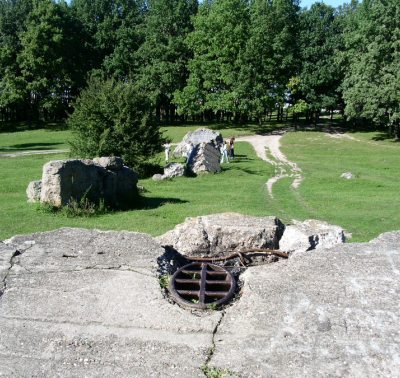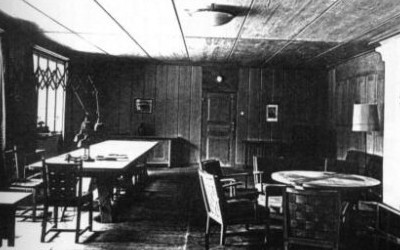

Werwolf or Werewolf in German is an abandoned bunker of Adolf Hitler situated in Werwolf Forest 8 kilometers North of Vinnytsia, Vinnytsia Oblast in Ukraine.
Location: Vinnytsia, Vinnytsia Oblast Map
Werwolf, also known as Führerhauptquartier Werwolf, was one of Adolf Hitler's military headquarters during World War II, serving as a command center on the Eastern Front. Located in a pine forest about 12 kilometers north of Vinnytsia in Ukraine, it was the easternmost headquarters Hitler personally used. Constructed between late 1941 and mid-1942 by the Organisation Todt using forced labor, the complex included bunkers, barracks, and amenities designed for strategic oversight of operations against the Soviet Union. Hitler stayed there intermittently from 1942 to 1943, totaling around 118 days, during which key decisions were made that influenced the war's course, such as directives leading to the Battle of Stalingrad. The site was destroyed by the Nazis in 1944 to prevent Soviet capture and now exists as a historical memorial complex amid ruins, symbolizing the brutality of Nazi occupation in Ukraine, including mass executions and forced labor. Despite its significance, Werwolf remains less known than other headquarters like Wolfsschanze, partly due to shorter usage and poor preservation.
Werwolf was situated in a dense pine forest, originally known as Wervolf Forest, between the villages of Stryzhavka and Kolo-Mikhailovka along the Kyiv highway, at coordinates 49°18′30″N 28°29′36″E and an elevation of 243 meters. This strategic placement near Vinnytsia—a major transport hub with railway connections and proximity to airfields like Kalinovka (20 km away)—facilitated logistics and communication. The site's selection considered camouflage from the surrounding woodland, access to a nearby granite quarry for materials, and integration with planned Nazi infrastructure, such as a trans-European highway to Crimea. The area spanned about 162,000 square meters, divided into three security zones: an inner core (Sperrkreis I) for high command, an administrative ring (Sperrkreis II), and an outer perimeter (Sperrkreis III) with defenses. The regional context included Vinnytsia as the Wehrmacht's headquarters and Luftwaffe bases, amid Ukraine's temperate climate with hot summers (up to 45°C) and humid conditions that plagued occupants. Nearby related sites included Göring's Anlage Steinbruch (30 km north) and Himmler's Hegewald (south of Zhytomyr), forming a network of Nazi command centers in occupied Ukraine.

Construction of Werwolf began on November 1, 1941 (or December 15
per some sources), under the code name Anlage Eichenhain (Oak
Grove), as part of the Nazi push eastward after occupying Vinnytsia
oblast in July 1941. Selected by General Rudolf Schmundt for its
infrastructure advantages over an initial site near Lubny, the
project was overseen by the Organisation Todt and divided into two
phases. The first phase (December 1941–July 1942) built core
structures using around 8,000 workers, including 1,200 Soviet POWs
and local civilians, who endured harsh conditions with minimal
rations. Approximately 4,000 laborers were executed upon completion
to maintain secrecy, buried in mass graves at Stryzhavka. The second
phase (January–July 1943) focused on expansions and winterization
with 1,250 workers.
The complex featured steel-reinforced
concrete bunkers (up to seven levels deep per some claims, with
2.5–3m thick walls), 20 wooden cottages and barracks connected by
tunnels, and amenities like a tea house, cinema, sauna, bathhouse,
barber shop, and gymnasium. A large vegetable garden supplied tested
food due to Hitler's poisoning fears, with water from artesian wells
and power from generators. Defenses included barbed wire,
minefields, anti-tank ditches, anti-aircraft guns, tanks, and
oak-tree observation posts. Camouflage involved planting 800 trees,
thousands of bushes, and 12,000 m² of grass. Total concrete usage
was 11,400 cubic meters, with 332,000 man-days invested, making it
Hitler's largest headquarters (among 14 completed out of 19
planned). The site supported broader Nazi atrocities in the region,
including the murder of over 200,000 civilians, 1,800 psychiatric
patients, and thousands of Jews in ghettos and camps, alongside
deportations for German resettlement plans.
Werwolf functioned as a forward command post for overseeing Eastern
Front operations, with Hitler staying there three times between 1942
and 1943. Security was rigorous, guarded by 3,000 SS personnel and
field gendarmes. Daily life revolved around Hitler's routines:
lunches in the Kasino (officers' club) with pre-tested meals,
outdoor meetings to mitigate disputes, and walks where he dictated
"Table Talks" on topics like anti-Slavic policies and
infrastructure. Heat, humidity, and mosquitoes caused discomfort,
exacerbating Hitler's health issues like influenza and headaches.
July 16–November 1, 1942: Longest stay; Hitler issued Directive
45 on July 23, splitting forces toward Stalingrad and the Caucasus,
contributing to major defeats. Hosted allies like Ante Pavelić and
Ion Antonescu; dismissed Franz Halder.
February 19–March 13,
1943: Oversaw Kharkov counteroffensive; promoted Heinz Guderian;
discussed armaments with Albert Speer.
August 27–September 15,
1943: Brief oversight of Kharkov defense post-Operation Citadel
failure.
Personnel included OKH staff in Vinnytsia, with
logistics seizing Ukrainian resources, leading to local starvation.
Travel involved armored convoys, flights, or 34-hour trains from
Berlin. Amenities like the swimming pool (misnamed today) went
unused by Hitler.
As Soviet forces approached, Werwolf was abandoned in early 1944. On Hitler's orders, Rudolf Schmundt directed its demolition starting January 1944: furniture and equipment were evacuated, wooden structures dismantled, and explosives (air bombs) detonated in bunkers, scattering fragments up to 60 meters and damaging the forest. The site was liberated by Soviets on March 20, 1944, who investigated under Stalin's orders but found no documents. NKGB uncovered mass graves nearby, including NKVD purge victims. Post-war, locals looted materials, and the underground sections were sealed.
Werwolf exemplifies Nazi engineering and paranoia, with its name tying into Hitler's "Wolf" motif and later guerrilla groups. It hosted pivotal decisions accelerating Germany's defeat and witnessed regional atrocities, including the Vinnytsia massacres. Less famous than Wolfsschanze due to no major events like assassination attempts, it links to figures like Claus von Stauffenberg, who served nearby and turned against Hitler. The site's obscurity reflects Ukraine's complex WWII historiography.
As of 2025, Werwolf is the "Wehrwolf Historical and Memorial Complex In Memory of the Victims of the Nazis," established in 2011. Open to visitors, it features scattered concrete ruins, the intact fire pond (often called Hitler's pool), informational boards on WWII history, and a small museum with artifacts. A nearby private museum displays unrelated WWII items. The site, overgrown with pines replanted in the 1970s, attracts history enthusiasts but lacks comprehensive signage or a full museum (plans unrealized as of 2018). It serves as a memorial to occupation victims, with no major changes reported in 2025.